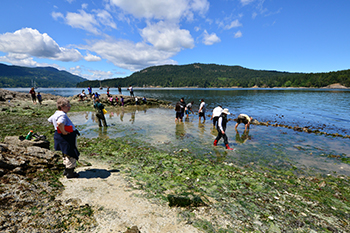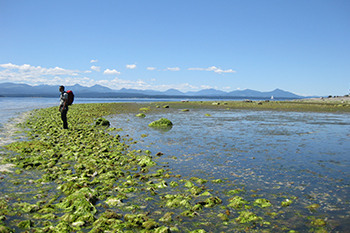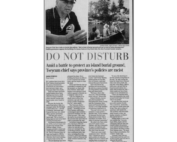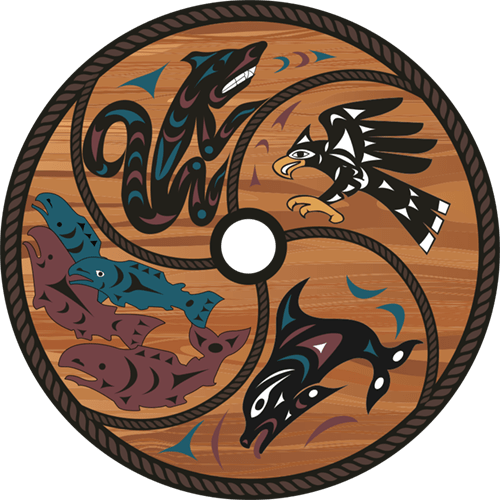The Clam Garden Restoration Project has reclaimed W̱SÁNEĆ knowledge, improved ecosystems and provided the W̱SÁNEĆ Nation with additional funding.
From 2014 to 2019, Parks Canada, the W̱SÁNEĆ Nation and the Hul’q’umi’num Nations participated in the Clam Garden Restoration project.
Clam gardens are ancient sites along shorelines in W̱SÁNEĆ territory that Indigenous people tended for thousands of years to enhance the production of clams and related sea creatures. Clams were an important source of protein for W̱SÁNEĆ people. The Clam Restoration project spent 5 years working to restore clam gardens in W̱SÁNEĆ territory. In addition to improving the ecology of two clam gardens, the project also aimed to reclaim W̱SÁNEĆ knowledge, practices and culture related to clam gardens.
The project was the first of its kind and drew interest from both the scientific community and neighboring Indigenous nations south of the border. Members of the Swinomish Nation traveled north from Washington State to learn and participate in the project, bringing W̱SÁNEĆ traditional knowledge back to their own communities for use in their clam gardens. W̱SÁNEĆ and Hul’q’umi’num Elders, harvesters and youths were joined on the Saltspring and Russell Island Clam Garden sites by scholars from Royal Roads University, Simon Fraser University and the University of Saskatchewan.
The Clam Garden restoration project provided scientists with data on ancient clam cultivating and harvesting practices while restoring traditional W̱SÁNEĆ knowledge related to clam gardens and their inhabitants: ȽÁU,₭EM/mussels, and ṮEX̱ṮEX̱/oysters, SQȽÁ ̧I ̧,/ittleneck clams, S’OX̱E/butter clams, ŚW̱ AAM/horse clam and ḴEXÁLS/digging clams.
In a video documenting The Clam Garden project, W̱SÁNEĆ Elder Jim Elliot shares:
“Clam harvesting has been important to our people for thousands of years. I believe it is one of the unique attractions to the coastline for Salish people. All year round you’d have a very valuable source of protein, right at your front door.”
Upon the project’s completion in late-2019, a report was authored by Joni Olsen. The document meticulously details the methods by which hundreds of highly productive clam gardens were managed by the W̱SÁNEĆ people throughout history. Included in the report are W̱SÁNEĆ Laws, W̱SÁNEĆ protocol for clam harvesting in a good way, information about SENĆOŦEN, and practical techniques for building and maintaining clam gardens.
W̱SÁNEĆ elders and knowledge keepers John Elliott J,SIṈTEN (W̱JOȽEȽP), Aaron Sam Mulmulach (SȾAU,TW̱), Herb Pelkey (SȾAU,TW̱), Tom Smith (W̱JOȽEȽP), Robert Sampson (W̱JOȽEȽP), Nathan Paradis (BOḰEĆEN), Katelyn Beale (W̱JOȽEȽP/W̱SIḴEM), Lorne Underwood (SȾAU,TW̱), Earl Claxton Jr. (SȾAU,TW̱), Jim Elliott (W̱JOȽEȽP), and Carl Olsen (W̱JOȽEȽP) were instrumental in the project’s success.
In the five years the project was underway, W̱SÁNEĆ elders and knowledge keepers were formally interviewed and their wisdom was put to good use to restore the clam gardens. Additional information was captured in the field, as well as from previously published sources where Elders shared their knowledge.
In an interview with the WLC, Joni Olsen–the report’s author and third-generation harvester–shares her insights into the project:
“The report creates a good foundation. It’s captured some of the history and relationship (between the W̱SÁNEĆ and Sea Gardens). We’ve captured enough data that youth could figure out how to manage a clam garden, but it hasn’t created sustainability.” Joni continues, “The clam garden is a great lesson in relationship with the Earth. We have a responsibility to care for these places. The more we care for them, the more it produces. There’s a direct correlation. The more you put into something, the more you get out of it. It’s a great way to learn the values of care of the earth.”
Ally Stocks, the Project Manager of the Clam Garden Restoration Project, stated that the Canadian Conservation and Restoration Program has just allocated funding for phase two, The Sea Garden Project.
The second phase of the clam garden project is slated to last five years as an extension of what was learned in the first phase. Ally continued,
“What we’ve learned is that it’s not just about clams . . . there’s not a direct translation for clam garden. A better name is Sea Garden. We want to look at other key species that are missing, like urchins and big clams, and make sure the ecosystem as a whole is healthy.”
When asked about the results of the clam garden project, Ally shares,
“We’ve been running an analysis of the data collected. While overall species numbers are in decline, we have seen benefits. There are more baby clams and increases in the density of native species the walls were built for, and that’s success in the Western mindset. From an Indigenous perspective, there are improvements in the way the beaches look, the number of squirting clams that can be seen. The health of the overall area has increased. The beaches are more likely to elicit the response, ‘This is a place I would cultivate.’”
In an effort to continue the momentum generated in phase one, the Sea Garden project will build capacity to ensure that W̱SÁNEĆ and Hul’q’umi’num Elders and Harvesters can continue to access the Sea Gardens without relying on Parks Canada for transportation to the sites.
The Sea Garden initiative is also intended to ensure it is safe and healthy to harvest from sea gardens, as well as simplifying the current shellfish testing process. Currently, all requests to test shellfish must be channeled through the cumbersome trifecta of DFO, the Canadian Food and Testing Agency, and Environment Climate Change, which form the Canadian Shellfish Sanitation Program.
Ally is excited to continue the work begun in phase one, “I think this is an incredibly powerful collaborative and inspiring project. It’s changed how the Gulf Islands National Park Reserve works” shares Stocks.
To stay up to date on this project, and to ensure you get notified about participating in onsite visits to the Sea Gardens, be sure to subscribe to the newsletter.
RECENT POSTS
How are we doing?
“The report creates a good foundation. It’s captured some of the history and relationship (between the W̱SÁNEĆ and Sea Gardens). We’ve captured enough data that youth could figure out how to manage a clam garden, but it hasn’t created sustainability.” Joni continues, “The clam garden is a great lesson in relationship with the Earth. We have a responsibility to care for these places. The more we care for them, the more it produces. There’s a direct correlation. The more you put into something, the more you get out of it. It’s a great way to learn the values of care of the earth.”








